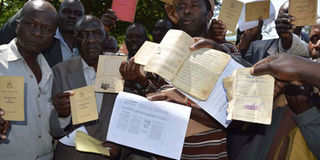Let Kenyans decide what to do about wide-ranging proposals in TJRC report

Former Kenya Air Force servicemen display their discharge certificates after a press conference in Kisumu on June 22, 2017. They said they were falsely accused of plotting a coup. And called for the implementation of the TJRC report. PHOTO | ONDARI OGEGEA | NATION MEDIA GROUP
What you need to know:
- The Commission also highlighted the harm that resulted from socio-economic crimes and corruption.
- The TJRC also set out guidelines for individual, collective and symbolic reparations.
Whatever the Supreme Court rules, it is clear that Kenya’s 2017 elections have brought into sharp relief, and simultaneously exacerbated, the level of political and ethnic polarisation in the country.
In turn, there is much discussion about how these divisions can be addressed – from calls for secession or more extensive devolution to the creation of political posts (for example, in the National Assembly or Senate) for runner’s up in the presidential race.
In such conversations, one option that frequently crops up is the implementation of the Truth, Justice and Reconciliation Commission (TJRC) report.
HUMAN RIGHTS
However, given that the report has not been widely read or discussed, it is timely to consider the Commission’s mandate, and what it actually found and recommended.
In turn – and given that it is impossible to do justice to a 2,000 page report in 700 words – here is a snapshot of some key facts.
The TJRC was established in 2009 and submitted a final report in 2013.
It was mandated to “promote peace, justice, national unity, healing, and reconciliation”.
To this end, it was tasked with establishing an historical record of violations and abuses of human rights and economic rights by state and non-state actors from independence on December 1963 to the end of the post-election crisis on February 2008.
VIOLATIONS
Violations to be investigated included acts of state repression, irregular land acquisition, perceptions of economic marginalisation, and causes of political violence and ethnic tension.
The Commission concluded that each regime had overseen widespread abuses and that Kenyans had suffered as a consequence.
More specifically, it found that state security forces had been “the main perpetrators of bodily integrity violations of human rights” – with northern Kenya standing as the epicentre of the same.
The Commission also found that, while the first Kenyatta regime (1963-1978) had been responsible for the highest number of political assassinations, repression of dissent had reached an apex under Moi’s one-party state (1978-1992).
CORRUPTION
In turn, while the Commission recognised various reforms initiated during Kibaki’s first term in office (2002-2007), it drew attention to ongoing corruption, ethnic favouritism and inter-communal violence, and to the collapse of the Narc coalition and increase in extra-judicial killings, which it argued prepared “fertile ground” for the post-election violence of 2007/8.
Those who bore the brunt of atrocities over time included political dissidents; residents of areas wracked by ethnic conflict and land disputes; communities in marginalised areas (namely, North Eastern, Upper Eastern, Coast, Nyanza, Western and North Rift regions); and members of vulnerable groups (namely, women, children, marginalised ethnic minorities, and the disabled).
The Commission also highlighted the harm that resulted from socio-economic crimes and corruption, and how even relatively developed areas had been marginalised at one point or another.
LAND DISPUTES
In terms of inter-communal conflict, the Commission blamed colonial rule and Britain’s adoption of a divide and rule strategy and the alienation of large tracts of land for the emergence of ‘negative ethnicity’ – with historical grievances over land cited as the “single most important driver of conflicts and ethnic tension”.
However, all post-colonial regimes were blamed for the perpetuation of such politics.
As, rather than provide redress, they “alienated more land from already affected communities for the benefit of politically privileged ethnic communities and the political elite”, and favoured members of their own ethnic groups in employment and appointment processes.
With ethnic differences then exacerbated by multiparty politics. These findings fed into wide-ranging recommendations.
REFORMS
This included further investigations, lustration and prosecution of alleged perpetrators, and state apologies for atrocities suffered.
It also included demands for the implementation of recommendations from previous commissions of inquiry; the fast tracking of ongoing reforms of state institutions; and enactment of key pieces of legislation.
The TJRC also set out guidelines for individual, collective and symbolic reparations.
This included a framework for individual compensation; development policies to address the historic marginalisation of certain regions; and establishment of various public memorials.
IMPLEMENT
Finally, the Commission made many more specific recommendations, such as the establishment of a “fully equipped national modern forensic laboratory”.
The Commission’s mandate, findings and recommendations are thus far-ranging.
It is up to Kenyans to decide whether or not they want to forget or to implement the report either in part or in full.
Gabrielle Lynch, Professor of Comparative Politics, University of Warwick, UK ([email protected]; @GabrielleLynch6)





